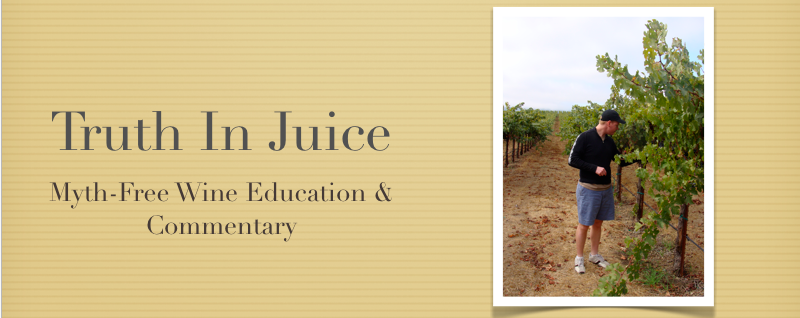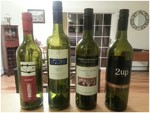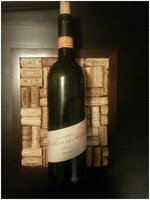A Look Down Under: Unique Terroir or Monsters of Terror?
 Wednesday, October 24, 2012 at 11:25PM
Wednesday, October 24, 2012 at 11:25PM When I first began drinking wine, Australian Shiraz was all the rage. In 2005, 2006, and 2007, wine lovers and wine critics loved powerful, rich, ripe wines, that were high in alcohol. Wines that were over 15% alcohol were not uncommon, and this hedonistic style was revered by noted wine critics such as Robert M. Parker Jr., other writers from The Wine Advocate and The Wine Spectator.
In fact, as late as October 31st, 2007, Jay Miller (who assumed coverage of Australia from Robert Parker in September, 2006) wrote that:
"The one disquieting aspect concerning Australia is the noisy minority of European wine lovers who seem to freak out over wines with more than 14% alcohol and too much flavor. While some producers seem to have scaled back the exuberance of their wines, I tasted very few wines that were out-of-balance. The fact of the matter is that nature provides what it does, and the best winemakers put that directly into the bottle. It should not be any other way."
Over time, the noisy minority of European wine lovers opposed to wines with more that 14% alcohol evolved into a majority of wine consumers, as sommeliers and wine writers railed against high alcohol wines, citing the difficulty of pairing these wines with food. Chief among these opponents of high alcohol, were Eric Asimov, wine columnist for The New York Times, and Rajat Parr, owner of RN74 Restaurant and Wine Director for the Michael Mina group of restaurants. Eric Asimov wrote in November 2006 that he had "a problem with many high alcohol wines," because he found that "they overwhelm a meal." Rajat Parr made bigger news when he elected not to feature any Chardonnay or Pinot Noir that had more than 14.5% on the wine list at RN74.
The issue of what constitutes an appropriate level of alcohol in wine has been a thorny one over the past several years. One the one hand, there are those who advocate for freedom of choice in alcohol levels, arguing that in some cases high alcohol levels cannot be avoided, due to the type of grape varietal, and climatic conditions that result in high sugar levels in grapes (and consequently) higher alcohol levels in wines. Lettie Teague, of The Wall Street Journal wrote an intriguing piece in support of high alcohol wines in April 2010. On the other hand, there are those who feel that wines over 14% alcohol are out of balance, and have created organizations designed to support California wineries producing wines that do not cross this threshold. In Pursuit of Balance, started by Rajat Parr and Jasmine Hirsch, of Hirsch Vineyards, states that:
"This growing group of producers is seeking a different direction with their wines, both in the vineyard and the winery. This direction focuses on balance, non-manipulation in the cellar, and the promotion of the fundamental varietal characteristics which make pinot noir and chardonnay great – subtlety, poise and the ability of these grapes to serve as profound vehicles for the expression of terroir."
However, as the calls for balance in wines grew ever louder, wines like Australian Shiraz, whose calling cards were anything but finesse, were forgotten, and relegated to second-citizen status. The decline of Australian Shiraz was an unfortunate result of wine fashion, for as the calls for finesse, balance, and grew louder, consumers fell in line and began echoing the call for more restrained, balanced wines. Ironically, although part of the call for balance and restraint was partially linked to a desire for a greater expression of terroir, Australian wine producers may have been demonstrating faithfulness to their country's terroir all along. In in one of his more extensive articles on Australia, a 2004 piece entitled "Australia: Thunder From Down Under," Robert Parker wrote that:
"One of the ironies about Australian wines is that the homegrown critics seem to exhibit a bias/prejudice against many of the old vine cuvées of Grenache and Shiraz because of their power and potency. This is unfortunate since nowhere else in the world can these wines be duplicated, and there seems to be considerable sentiment among the Aussie wine press that the Barossa, Eden Valley, and McLaren Vale wineries should put on the brakes, and produce wines that do little more than imitate French, Spanish, or Italian efforts. This would be a disaster since no country has demonstrated the ability to compete with the great classics of France, Spain, or Italy. To go against the fundamental climatic conditions that are not conducive to making elegant, finesse-styled wines is fraught with disaster, and those wineries that believe they can out-perform Europe in terms of finesse and elegance frequently turn out innocuous, manipulated wines with little soul or character."
Although the sentiment exhibited by the Australian wine press would eventually come to dominate the vast majority of the wine trade, there is a sense of irony in the fact that the movement for low-alcohol wines was driven in large part by a desire for non-manipulation, and a greater expression of terroir in the wines. However, as Parker points out, in Australia, non-manipulation and expression of terroir may result in high alcohol wines, due to the country's uniquely warm climate and exceptionally ripe grapes. Even those of the In Pursuit of Balance crowd freely admit that their calls for restraint and balance are primarily aimed at Pinot Noir and Chardonnay. Rajat Parr has admitted that he will allow wines over 14.5% alcohol at RN74, so long as they are not made from Burgundian grapes.
Yet while the calls for balance and restraint from some members of the wine trade may have been varietally specific, the effects of that movement had far reaching effects on the place of Australian wines in the US market. As the American public learned to associate Australian wines with high alcohol levels, and bold, rich, fruit flavors, Australian wines were among the first casualties of the new found American preference for elegant, restrained wines. As rich, ripe, powerful wines fell out of style, American wine merchants reduced the amount of Australian wine that they kept on their shelves.
The changing perception was reflected in sales of Australian wines, the sales of Syrah/Shiraz in general, and in the philosophies of American winemakers. Eric Asimov wrote a column in June of 2010, entitled "Is There Still Hope for Syrah?" In the column, Asimov addressed the fact that many American winemakers had attempted to emulate Australian Shiraz in the late 1990s and late 2000's, due to the high scores being awarded to those wines by critics. Asimov quoted winemaker Pax Mahle, who had made rich, high-alcohol Syrah for Pax Wine Cellars, but later left the winery and began to produce more restrained Syrah for Wind Gap.
“The Pax wines were good of their kind, but I found on a Tuesday or Wednesday night they were the wines I least wanted to drink,” Asimov quoted Pax as saying.
I had to admit, there was a degree of truth in Mr. Mahle's statement. I could recall certainly times when a big, rich, high alcohol wine was the last thing that I wanted. However, I could also think of times when a big, rich, plush, velvety wine had been a source of comfort and enjoyment. In that respect, maybe the difference between the enjoying the wines considered to be restrained and balanced, and the rich, plush wines desribed by some as "monsters," was as simple as the concept of drinking seasonally. After all, I believe that life is too short for one wine, and will welcome any well made wine into my home. Having both styles of wine available is a positive thing in my book. Yet, I wondered, if winemakers could be so influenced by scores and critics, then what was to stop them from being influenced by the movement calling for more restraint and balance in their wines? Why was it better to promote low alcohol levels in a wine, than to promote higher alcohol contents?
As I pondered the topic further, I realized that the effects of wine fashion had taken their toll on me as well. I had not consistently enjoyed Austalian wines in quite some time. In an effort to rectify this situation, I headed out to Burlington Wine Shop. It was a Saturday, and there was a free tasting taking place in store. Coincidentally, one of the wines being featured that day was an Australian Shiraz, the 2009 Evans Wine "Bulletin Place" Shiraz, South Eastern Australia. When I took my first sip, I was somewhat confused. This wine did not have any of the rich, powerful, ripe fruit characteristics that I had come to associate with Australian Shiraz. Instead, I was greeted by an intriguing nose of sour berries, dark fruits, earth, and a hint of bacon. On the palate, the wine was medium bodied, and well balanced, with flavors of black cherry, and kirsch liqueur. I glanced at the wine's price tag, saw $8.99, and looked quizzically at Brad, the shop owner.
"I was somewhat suspicious when the rep brought it in," he said with a wry smile. "I mean, an inexpensive Australian Shiraz? But I tasted it, and it was good, and it just kept getting better in the glass."
Encouraged by my experience with the Bulletin Place, I bought a bottle, along with 3 other bottles of Australian Shiraz, and headed home to do a blind tasting. I placed the wines in paper bags to mask their identities, and sat down at the table with my girlfriend, and my friends Charlie and Kevin. Alongside the Bulletin Place, I poured the 2009 Hope Estate Shiraz ($11.99), from the Hunter Valley, the 2008 Mark Davidson Tamburlaine "North Bore" Shiraz ($10.99), from New South Wales, and the 2010 Kangarilla Road "2Up" Shiraz ($11.99), from McLaren Vale. All of the wines showed well, but curiously only the Kangarilla Road "2Up" was reminiscent of the bold, powerful style of Shiraz I remembered from 2005, 2006, and 2007. With a deep purple color, a nose of meaty dark fruit, and candied fruits and blackberry jam on the palate, it was a real crowd pleaser.
However, the "2Up" was edged out for first place by the Bulletin Place, which stole the show in the blind tasting, as it had in the tasting at the store, and produced a most memorable quote in the process. It was the first wine I poured in the tasting, and somehow, my girlfriend had missed my announcement that we would be tasting Shiraz that night. As she sipped the wine, one of my friends alluded to the fact that it was a Shiraz. Upon hearing this, my girlfriend exclaimed, "This is not Shiraz!"
I didn't respond to her declaration, and merely smiled at her. "No way...," she murmured, taking another sip. "It can't be... It's too light bodied."
As we unveiled the wines later, we made a point to look at the labels on the Shiraz. To our surprise, none of them had an alcohol content above 14%. Both the Bulletin Place and the "2Up" were listed at 14%, while the Mark Davidson Tamburlaine "North Bore" Shiraz and the Hope Estate Shiraz weighed in at a slightly lower 13.5%. The alcohol content of the latter two was understandable, given that New South Wales and the Hunter Valley are regarded as relatively cooler climates in the Australian spectrum. Yet, to see wines from McLaren Vale and South Eastern Australia with alcohol contents of 14% was somewhat shocking. It was as if the effects of wine fashion had forced a more delicate style on these powerful regions.
I appreciated the stylistic variety demonstrated by the Shiraz in the tasting, but a sentimental part of me longed for the big, hedonistic Shiraz that had been so popular when I first began to drink wine. I wondered if the movement towards elegance and restraint had rendered this style obsolete. I want to see Australian wines experience a resurgence, but Robert Parker's words left me questioning whether the success of Australian wines in a market that emphasized balance would require the abandoning of the unique character bestowed upon them by the Australian climate.
Wine blogger Alder Yarrow posted a transcript from a panel discussion on alcohol levels in Pinot Noir, hosted by Eric Asimov in March, 2011. The transcript included a quote from Jim Clendenden, owner and winemaker at Au Bon Climat, on stylistic decision making in wine. "But just do not ever walk up to me and tell me bigger, darker, and heavier connotes anything but a stylistic choice," Mr. Clendenden said. "It does not connote or denote anything resembling success. It is a choice of style, and so many things in fashion and art just come and go."
Mr. Clendenden's comments were made in reference to Pinot Noir, but they encapsulated the feelings of the movement that had rendered so many Australian wines to second-tier status. As a final test, I went to my cellar, and pulled out one of the bottles of Australian Shiraz that I had purchased many years ago, a 2002 Brothers in Arms Shiraz from Langhorne Creek in South Australia. The alcohol content on the label was listed at 15%, but when I opened the wine, and took a sip, it did not seem unbalanced. Although it was 10 years old, it revealed few signs of its age, except for a slightly faded color at the edge of the glass. Otherwise, it was still an inky, dark, opaque purple. Aromas of dark fruits, fennel, spice, and chocolate wafted from the glass. On the palate, it displayed a silky smooth structure, with flavors of chocolate, raspberry, mint and eucalyptus. If a percentage point of alcohol could turn some people away from this wine, I'd gladly take it for myself, I thought.
Ultimately, my reexamination of Australian wines left me hopeful that the country's wines might be making a comeback, but left me with many questions regarding the attitudes that the low alcohol wine movement had instilled in the country's wine connoisseurs. What difference do a few percentage points in the alcohol content of a wine really make, provided that the wine is in balance, and that the alcohol content was not the result of manipulation? At the end of the day, most wine conoisseurs seek natural, balanced wines that speak of the places they are from. To that end, it seems fitting that high alcohol levels would be an enemy, as the number of places and grape varietals that can yield wines with high alcohol content, and still retain character and balance are limited. However, in the case of some wines, such as Australian Shiraz, high alcohol content, and a powerful, rich, bold style are the hallmarks of the native climate, and serve as a different expression of terroir. To take pleasure in these wines should not discount a consumer's ability to enjoy wines that are delicate, restrained, and balanced. They are opposite ends of the spectrum. Too often, the world of wine looks to promote one style of wine at the expense of another. Yet, when one considers the countless opportunities and occasions in which it is possible to enjoy wine, it is readily apparent that there is room for many styles of wine: hedonistic or restrained.





Reader Comments